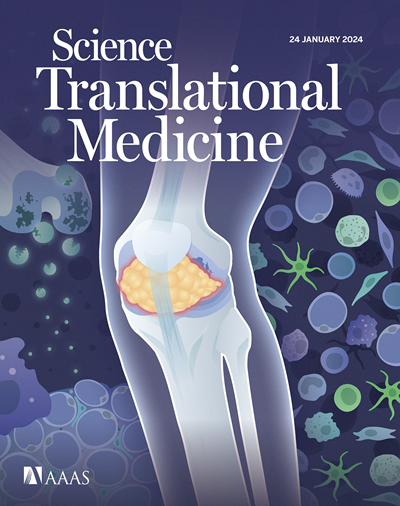使用非条件作用策略的全脑小胶质细胞替代改善了神经系统疾病小鼠模型的病理
IF 15.8
1区 医学
Q1 CELL BIOLOGY
引用次数: 0
摘要
越来越多的遗传和病理证据已经确定小胶质细胞功能障碍是各种神经系统疾病发病和进展的关键因素,将小胶质细胞替代定位为一种有前途的治疗策略。传统的骨髓移植(BMT)用于补充脑小胶质细胞的方法存在局限性,包括效率低,并且由于预处理方案(如放疗或化疗)可能导致脑损伤。此外,迁移到大脑的脑转移源性细胞不能再现驻留小胶质细胞的表型和功能特性。在这里,我们提出了一种没有任何条件的小胶质细胞移植策略,称为“三环小胶质细胞移植耗竭”(TCMDT)。该方法利用集落刺激因子1受体(CSF1R)抑制剂PLX3397进行三个周期的小胶质细胞耗竭,为外源性小胶质细胞的有效植入创造了最佳窗口。TCMDT移植原代培养小胶质细胞成功地恢复了内源性小胶质细胞的身份和功能。为了评估TCMDT的治疗潜力,我们将这一策略应用于两种不同的神经系统疾病小鼠模型。在Sandhoff病模型中,一种由己糖氨基酶亚单位β (Hexb)缺乏引起的神经退行性溶酶体储存障碍,TCMDT有效地替代了缺乏的小胶质细胞,减轻了神经变性并改善了运动表现。同样,在携带髓系细胞2 (Trem2) R47H突变触发受体的阿尔茨海默病(AD)相关淀粉样蛋白小鼠模型中,我们的移植策略挽救了小胶质细胞功能障碍并减轻了AD相关病理。总的来说,我们的研究介绍了TCMDT作为一种实用、有效、安全的小胶质细胞替代方法,提示治疗与小胶质细胞功能障碍相关的神经系统疾病的治疗潜力。本文章由计算机程序翻译,如有差异,请以英文原文为准。
Brain-wide microglia replacement using a nonconditioning strategy ameliorates pathology in mouse models of neurological disorders
Growing genetic and pathological evidence has identified microglial dysfunction as a key contributor to the pathogenesis and progression of various neurological disorders, positioning microglia replacement as a promising therapeutic strategy. Traditional bone marrow transplantation (BMT) methods for replenishing brain microglia have limitations, including low efficiency and the potential for brain injury because of preconditioning regimens, such as irradiation or chemotherapy. Moreover, BM-derived cells that migrate to the brain do not recapitulate the phenotypic and functional properties of resident microglia. Here, we present a microglia transplantation strategy devoid of any conditioning, termed “tricyclic microglial depletion for transplantation” (TCMDT). This approach leverages three cycles of microglial depletion using the colony stimulating factor 1 receptor (CSF1R) inhibitor PLX3397, creating an optimal window for efficient engraftment of exogenous microglia. Transplantation of primary cultured microglia by TCMDT successfully restored the identity and functions of endogenous microglia. To evaluate the therapeutic potential of TCMDT, we applied this strategy to two distinct mouse models of neurologic disorder. In a Sandhoff disease model, a neurodegenerative lysosomal storage disorder caused by hexosaminidase subunit beta (Hexb) deficiency, TCMDT effectively replaced deficient microglia, attenuating neurodegeneration and improving motor performance. Similarly, in an Alzheimer’s disease (AD)–related amyloid mouse model carrying the triggering receptor expressed on myeloid cells 2 (Trem2) R47H mutation, our transplantation strategy rescued microglial dysfunction and mitigated AD-related pathology. Overall, our study introduces TCMDT as a practical, efficient, and safe approach for microglia replacement, suggesting therapeutic potential for treating neurological disorders associated with microglial dysfunction.
求助全文
通过发布文献求助,成功后即可免费获取论文全文。
去求助
来源期刊

Science Translational Medicine
CELL BIOLOGY-MEDICINE, RESEARCH & EXPERIMENTAL
CiteScore
26.70
自引率
1.20%
发文量
309
审稿时长
1.7 months
期刊介绍:
Science Translational Medicine is an online journal that focuses on publishing research at the intersection of science, engineering, and medicine. The goal of the journal is to promote human health by providing a platform for researchers from various disciplines to communicate their latest advancements in biomedical, translational, and clinical research.
The journal aims to address the slow translation of scientific knowledge into effective treatments and health measures. It publishes articles that fill the knowledge gaps between preclinical research and medical applications, with a focus on accelerating the translation of knowledge into new ways of preventing, diagnosing, and treating human diseases.
The scope of Science Translational Medicine includes various areas such as cardiovascular disease, immunology/vaccines, metabolism/diabetes/obesity, neuroscience/neurology/psychiatry, cancer, infectious diseases, policy, behavior, bioengineering, chemical genomics/drug discovery, imaging, applied physical sciences, medical nanotechnology, drug delivery, biomarkers, gene therapy/regenerative medicine, toxicology and pharmacokinetics, data mining, cell culture, animal and human studies, medical informatics, and other interdisciplinary approaches to medicine.
The target audience of the journal includes researchers and management in academia, government, and the biotechnology and pharmaceutical industries. It is also relevant to physician scientists, regulators, policy makers, investors, business developers, and funding agencies.
 求助内容:
求助内容: 应助结果提醒方式:
应助结果提醒方式:


